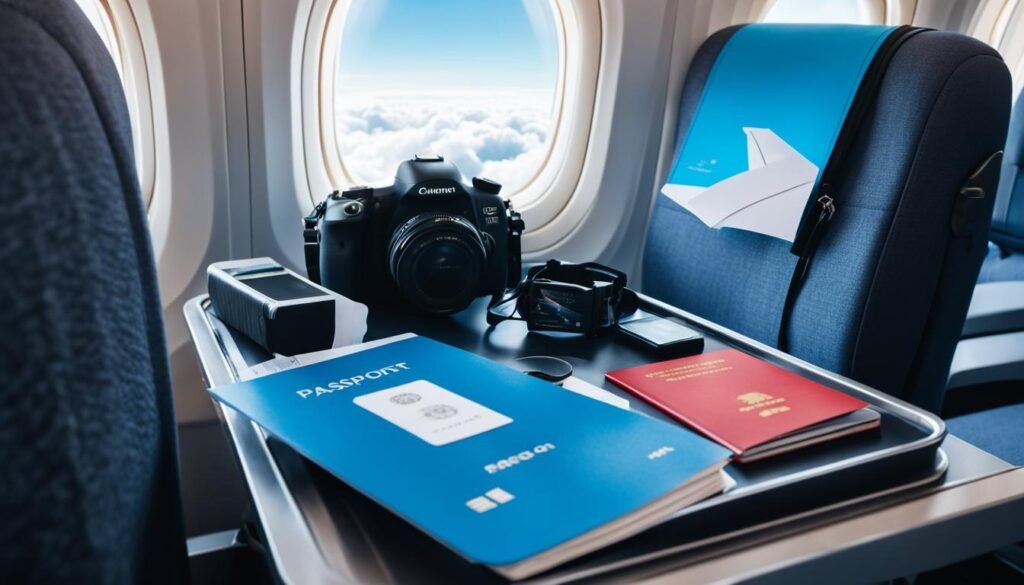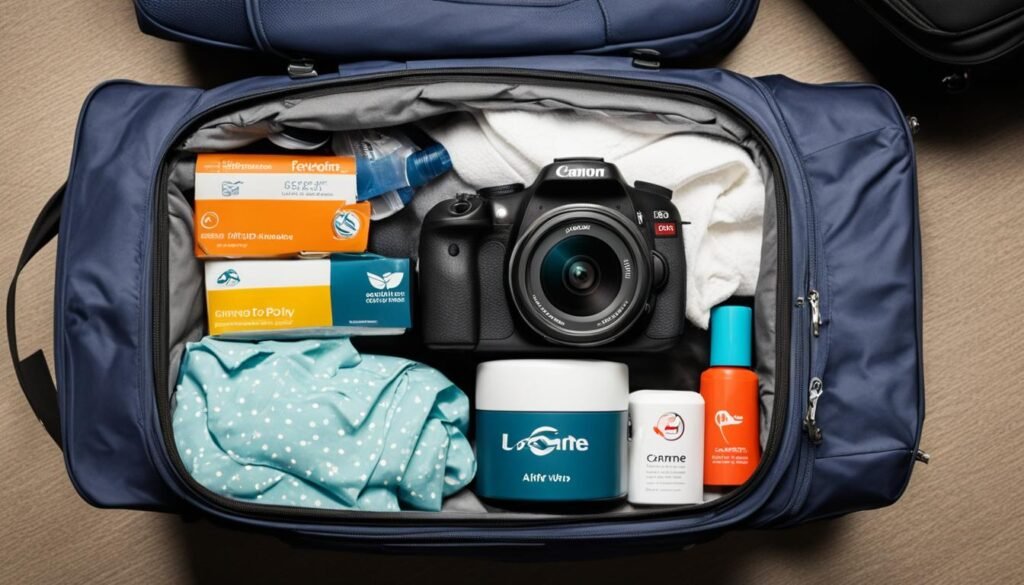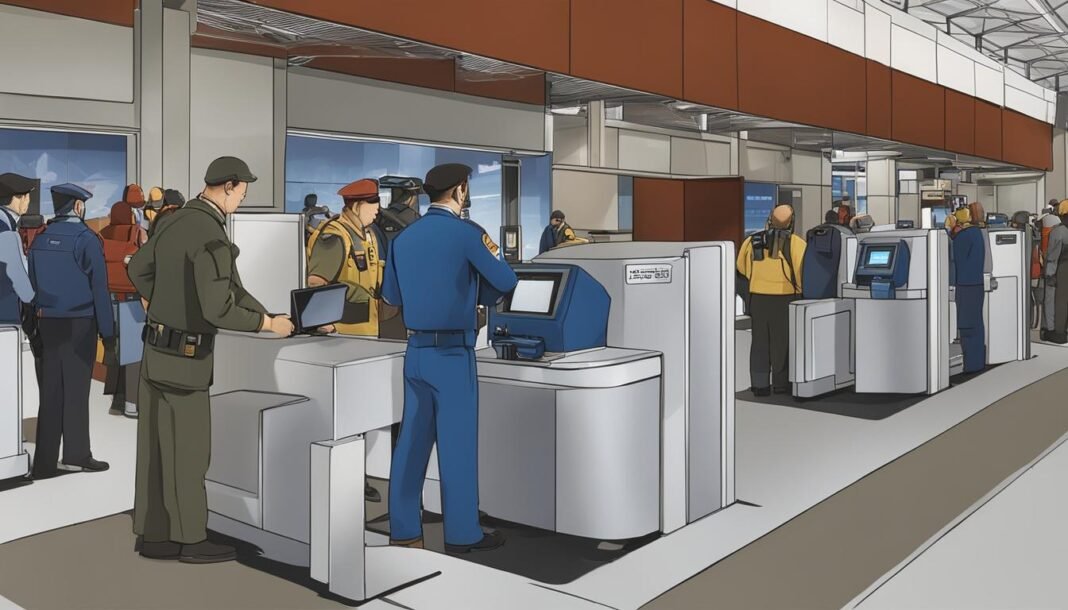For photography enthusiasts, bringing a camera on a plane is a must-have to capture memorable moments and breathtaking landscapes.
However, before packing your camera and accessories, it’s essential to understand the rules and regulations regarding camera restrictions on airplanes. Not complying with TSA camera regulations can result in delays, loss of equipment, and missed flight departures.
Airlines and airports have specific guidelines on what types of photography equipment can be carried on or checked in a plane, which necessitates giving due consideration to packing, securing, and making other preparations before traveling with a camera.
Know the ins and outs of bringing a camera on your next flight by reading on to learn about the TSA camera regulations, navigating airline policies, packing tips, checked baggage, and security clearance tips.

Key Takeaways
- Before flying, familiarize yourself with TSA camera regulations to avoid any inconvenience or loss of equipment.
- Most airlines have specific guidelines on the size, weight, and number of cameras that can be carried on a plane, so plan accordingly.
- Securing and protecting your camera gear is paramount when packing, whether in a carry-on or checked baggage.
- When traveling with camera equipment, awareness of delicate gear and local restrictions is crucial to ensuring a successful travel photography experience.
- Follow TSA regulations, including removing your camera from bags during security clearance, to ensure a smooth and stress-free experience.
TSA Camera Regulations: Can You Bring a Camera on a Plane?
Beyond airline policies, the TSA has specific regulations regarding cameras on planes. It’s important to familiarize yourself with these guidelines before packing your camera for air travel.
Camera Bag Size Restrictions
The size of your camera bag will affect whether you can bring it on the plane as a carry-on or if it will need to be checked. The TSA does not limit the size of camera bags, but individual airlines may have their restrictions. Be sure to check with your airline before packing your camera bag.
Prohibited Camera Accessories
The TSA prohibits certain camera accessories from being brought on planes. This includes tripods that exceed carry-on size limits, selfie sticks, and monopods. These items must be checked or left at home.
Additional Screening Procedures
In some cases, the TSA may require additional screening procedures for cameras or photography equipment. This could include removing your camera from its bag, inspecting film or memory cards, or swabbing for explosive residue. If you’re unsure about the screening process, contact your airline or the TSA for more information.
“It’s important to research TSA guidelines before traveling with a camera to avoid any unexpected surprises at airport security.”
Carry-On Camera Rules: Navigating Airline Policies
When it comes to bringing your camera on a flight, understanding the carry-on camera rules set by different airlines can help you avoid any surprises. While most airlines have similar guidelines, it’s important to check with your specific airline to ensure you comply with their rules and regulations.
Generally, most airlines allow passengers to bring one camera and one camera bag as a carry-on item. However, some airlines may have restrictions on the size and weight of the bag, and whether or not it can count towards your overall carry-on baggage limit. It’s important to double-check with your airline to ensure you’re within their allowed limits.
When packing your camera, be aware that TSA regulations may apply. Cameras and camera equipment must be screened separately at security checkpoints, so it’s important to pack them in an easily accessible location in your bag. Additionally, batteries and chargers should be packed in your carry-on luggage, and spare batteries should be kept in their original packaging or a protective case.

Remember that if you’re traveling with a larger camera or telephoto lens, you may be required to stow it in the overhead compartment or a bulkhead seat. If you’re uncertain about the size of your camera, don’t hesitate to reach out to your airline before your flight to ensure that you have all the necessary information.
Packing Tips: Securing and Protecting Your Camera Gear
When traveling with a camera, it’s important to take the necessary steps to pack and secure your gear properly. This will help protect your equipment from damage or theft during the journey, as well as making sure you can efficiently bring cameras through airport security.
Invest in a Padded Camera Bag
The most important element of packing your camera is the bag that you use to transport it. A padded camera bag will help protect your equipment from bumps, drops, and other potential damage. Look for a bag that is specifically designed for camera equipment, with sturdy padding and compartments to keep your gear organized and secure. Additionally, check the dimensions of your bag to ensure it meets airline regulations for carry-on or checked luggage, depending on your needs.
Organize Your Accessories
When packing your camera bag, take time to organize your accessories and additional equipment. Organizing your gear will not only make it easier to access your equipment when you need it, but it will also protect your gear from damage. Use separate compartments for each item, and make sure to pack fragile accessories, such as lenses and filters, in protective cases.
Secure Delicate Equipment
For particularly delicate equipment, such as tripods or drones, consider investing in additional protective cases or bags. These will help protect your gear during transit and make it easier to carry your equipment around once you arrive at your destination.
Label Your Bag Clearly
Make sure that your camera bag is labeled clearly with your name and contact information. In the event that your bag is lost or mistakenly taken by another traveler, having clear identification will help ensure that your gear is returned to you safely.
Consider a TSA-Approved Lock
If you are checking your camera bag, consider investing in a TSA-approved lock. These locks can be opened by TSA agents for security checks without damaging your bag.
Remember, the key to traveling with camera gear is to pack and secure your equipment properly. By taking the necessary precautions, you can protect your gear and ensure a smooth travel experience.
Checked Baggage: Can Cameras Be Safely Packed?
If you’re planning to bring photography equipment on your trip but don’t want to deal with carrying it on, packing your camera and gear in your checked baggage might seem like a viable option.
However, before choosing this method, it’s important to consider the following:
- Camera restrictions on airplanes: Keep in mind that certain types of photography equipment, such as lithium batteries, may have specific limitations or restrictions when it comes to being packed in checked baggage. Always check with your airline beforehand.
- Packing camera for air travel: When packing your camera in checked baggage, be sure to take appropriate steps to secure and protect it, such as using padded inserts or wrapping it in clothing.
- Potential damage: Checked baggage is subject to rough handling and may be exposed to extreme temperatures and other hazards during transit, increasing the risk of damage to your camera and gear.
- Theft: Unfortunately, checked baggage is also at risk of theft or loss, so it’s essential to make sure your camera equipment is adequately insured and to consider packing high-value items in your carry-on luggage instead.

Ultimately, the decision to pack your camera in checked baggage should be based on your individual circumstances and preferences. However, it’s crucial to understand the risks involved and take appropriate precautions to ensure the safe arrival of your camera and gear.
Photography Equipment on Planes: Special Considerations
When it comes to bringing your photography equipment on a flight, it’s essential to be aware of any special considerations or regulations that may apply. Certain pieces of gear, such as drones, tripods, and large telephoto lenses, may require additional handling or permission.
Firstly, for travelers bringing a drone on a plane, it’s important to note that most airlines and airports have specific regulations in place regarding their transport. In general, drones are not permitted as checked baggage and must be carried on the plane as a personal item or in a carry-on bag. It’s also crucial to check local regulations and obtain any necessary permits before flying a drone in a new location.
For travelers with large telephoto lenses or other bulky camera equipment, it’s important to be aware of potential size restrictions for carry-on bags. Many airlines have specific size and weight limits for carry-on luggage, which can vary depending on the airline and travel destination. Consider investing in a high-quality backpack or camera bag that meets the airline’s requirements while still providing ample protection for your equipment.
Pro tip: To avoid any confusion or issues at security checkpoints, be sure to remove any cameras or accessories from your bag before x-ray screening. This can help expedite the process and prevent any damage to your gear from being mishandled or dropped by TSA agents.
Additionally, travelers with tripods or other camera stands may find it challenging to transport them on a flight. While these items can generally be included as carry-on baggage, their size and weight may make them inconvenient or uncomfortable to carry. Consider investing in a lightweight, collapsible tripod that can be easily packed away when not in use.
| Photography equipment | Special considerations |
|---|---|
| Drones | Check local regulations; carry-on only |
| Telephoto lenses | Be aware of size restrictions for carry-on bags |
| Tripods | Invest in a lightweight, collapsible option |
By taking the time to research and understand any special considerations regarding photography equipment on planes, travelers can ensure a smooth and stress-free travel experience. Whether you’re a professional photographer or a casual hobbyist, having the right gear on hand can help you capture stunning images and make lasting memories during your travels.
Clearing Security: Tips for a Smooth Experience
Bringing cameras through airport security can be a daunting process, but the key to a hassle-free experience is preparation. By following TSA camera regulations and taking a few simple steps to properly pack and present your camera at the checkpoint, you can ensure a smooth clearance and avoid any delays or issues.
Here are some helpful tips for navigating airport security with cameras:
- Know the rules: Before you travel, familiarize yourself with the current TSA camera regulations to avoid potential issues at the checkpoint. Remember that all cameras and equipment must be screened separately at the checkpoint.
- Keep it accessible: Pack your camera bag so that your camera and its accessories are easily accessible for screening. Avoid cramming too much equipment into a single bag and use a dedicated padded camera bag to protect your gear.
- Separate accessories: Remove any additional accessories such as lenses, batteries, and memory cards and place them in separate bins for X-ray screening. This will allow the TSA agents to get a clear view of your camera and speed up the screening process.
- Be polite and patient: Remember that the TSA agents are working to keep everyone safe. Answer questions truthfully, follow instructions, and remain patient throughout the process.
By following these simple tips and adhering to TSA camera regulations, you can speed up the process and breeze through airport security with your camera gear in tow.
For more information on packing and transporting your camera for air travel, check out our previous sections or visit the TSA website.
Travel Photography Best Practices: Making the Most of Your Trip
Bringing a camera on a flight is a great way to capture memories and document your travels. However, it’s important to remember that photography equipment on planes can come with its own unique set of challenges and considerations. To ensure that you make the most of your trip and come home with stunning photos, here are some travel photography best practices to keep in mind.
Be Prepared
Before you set out on your travels, take some time to research the area and the types of photography opportunities that may exist. Consider the time of day, lighting conditions, and any special events or attractions that may be worth capturing. It’s also a good idea to pack spare batteries, memory cards, and any accessories you may need to get the perfect shot.
Respect Local Regulations
When taking photographs in a new location, it’s important to remember that local regulations may apply. Some sites, landmarks, or cultural events may prohibit photography altogether, while others may have specific rules or guidelines that must be followed. Always do your research ahead of time and ask permission if necessary to avoid any unintended consequences.
Get Creative
While it’s important to capture the iconic sights and experiences of your trip, don’t be afraid to get creative with your shots. Try experimenting with different angles, foregrounds, and perspectives to showcase your unique perspective on the world. Capture the small details that make your trip special, from local street art to food and drink experiences, and everything in between.
Be Respectful
Remember that your photography can have an impact on the people and places you encounter on your trip. Always be respectful and considerate when taking photos of locals or cultural sites, and avoid disrupting or interfering with any activities or events. Be mindful of your surroundings and take steps to minimize any impact your photography may have.
Read More:
- Can You Bring a PS5 on a Plane?
- Can You Bring a Pipe on a Plane?
- Can You Bring a Pencil Sharpener on a Plane?
- Can You Bring a Parachute on a Plane? Tips & Rules
- Can You Bring a Cigar Cutter on a Plane?
- Can You Bring a Blender on a Plane? Easy Travel Tips
- Flying Fit: Can I Bring Pre Workout on a Plane?
- Can I Bring My Dyson Airwrap on a Plane?
- Can I Bring Face Wash On A Plane? TSA Rules
- Can You Bring Delta 8 on a Plane?
Frequently Asked Questions
Can I bring a camera on a plane?
Yes, you can bring a camera on a plane. However, it is important to familiarize yourself with the rules and regulations set by the Transportation Security Administration (TSA) and individual airlines to ensure a hassle-free travel experience.
What are the TSA camera regulations?
The TSA has specific regulations regarding cameras on planes. This includes restrictions on the size of camera bags allowed as carry-on luggage and prohibited camera accessories. It is important to review these regulations before traveling.
Are there carry-on camera rules for airlines?
Yes, different airlines may have their own carry-on camera rules. These rules may include guidelines on the number of cameras allowed, size restrictions, and whether camera equipment counts toward carry-on baggage limits. It is advisable to check with your specific airline before your flight.
How should I pack and secure my camera gear for air travel?
When packing your camera gear for air travel, it is important to use a padded camera bag to protect your equipment. Organize accessories and delicate items properly to minimize the risk of damage during the journey.
Can I pack my camera in checked baggage?
While it is possible to pack cameras and photography equipment in checked baggage, there are certain considerations to keep in mind. These include the risk of damage, potential theft, and ensuring proper insurance coverage for your gear.
Are there any special considerations for specific photography equipment on planes?
Yes, certain types of photography equipment may have additional regulations or restrictions when traveling on planes. This may include drones, tripods, or large telephoto lenses. It is important to review the specific regulations related to your equipment before your flight.
How can I ensure a smooth experience when bringing cameras through airport security?
To ensure a smooth experience when bringing cameras through airport security, follow TSA regulations. This may involve removing cameras from bags, separating accessories, and being aware of any specific screening procedures related to camera gear.
Any tips for travel photography best practices?
When practicing travel photography, it is important to make the most of your trip. Capture memorable moments, seek out photography opportunities, and respect local regulations and cultural sensitivities when taking photographs.


